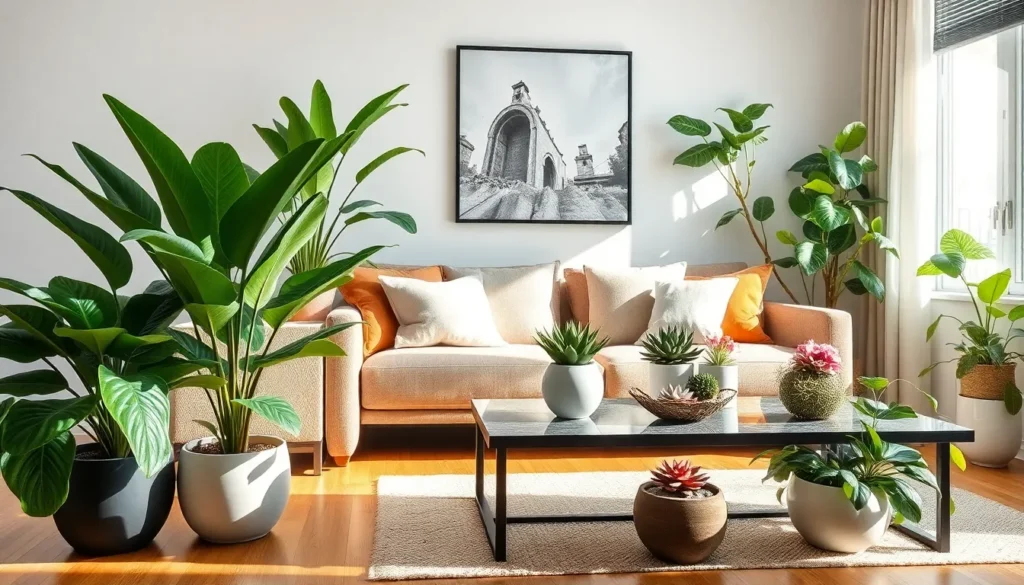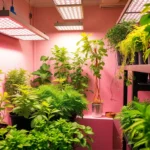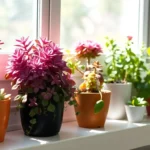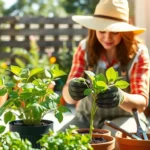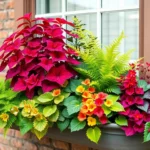We’ve all been there – standing in the plant aisle dreaming of a lush living room but knowing deep down that our busy schedules and less-than-green thumbs spell disaster for real plants. That’s where faux plants come to the rescue, offering all the beauty of nature without the maintenance headaches.
Today’s artificial plants aren’t the dusty plastic eyesores your grandmother had tucked in her corner. Modern faux plants look incredibly realistic and can transform your living room into a vibrant oasis that’ll have guests doing double-takes. From towering fiddle leaf figs to cascading pothos vines, there’s a perfect artificial plant waiting to elevate your space.
The best part? You’ll never worry about watering schedules, proper lighting, or pet safety again. We’re about to show you how to choose, style, and arrange faux plants that’ll make your living room the envy of every plant parent – without any of the stress.
Choose The Right Size Faux Plants For Your Living Room Space
Selecting the proper size faux plants transforms your living room from cluttered chaos to harmonious haven. We’ll guide you through the essential measurements and proportions that create stunning artificial plant displays.
Consider Room Proportions And Ceiling Height
Large faux plants work best in spacious living rooms with ceilings 9 feet or higher. Floor plants like fiddle leaf figs, palms, and monstera deliciosa should measure 5 to 7 feet tall in rooms with standard 8 to 9 foot ceilings. Rooms with vaulted or cathedral ceilings accommodate dramatic 8 to 10 foot artificial trees without overwhelming the space.
Small living rooms require more modest plant selections to avoid visual congestion. Compact spaces under 200 square feet benefit from faux plants measuring 2 to 4 feet in height. Corner plants shouldn’t exceed two thirds of your ceiling height to maintain proper scale relationships.
Medium sized rooms offer the most flexibility for mixing plant heights. Spaces between 200 to 400 square feet accommodate a combination of floor plants, tabletop varieties, and hanging specimens. We recommend keeping your tallest artificial plant at least 18 inches shorter than your ceiling height.
Match Plant Scale To Furniture Size
Oversized sectional sofas pair beautifully with substantial floor plants. Large L shaped or U shaped seating arrangements require faux plants with broad canopies like artificial palms or rubber trees. These substantial plants should measure at least 4 feet wide to complement generous furniture proportions.
Compact loveseats and apartment sized sofas work better with smaller scale artificial plants. Two seater furniture pieces coordinate with tabletop faux plants measuring 12 to 24 inches tall. Snake plants, pothos, and small fiddle leaf figs create perfect proportional relationships.
Coffee tables and side tables determine appropriate plant container sizes. Round coffee tables accommodate circular planters up to one third of the table’s diameter. Rectangular tables work with oval or square planters that don’t exceed half the table’s length.
Create Visual Balance With Multiple Heights
Layer different sized faux plants to establish natural looking depth and dimension. Start with one large floor plant as your anchor piece, then add medium sized plants on plant stands or furniture surfaces. Small trailing plants on floating shelves or mantels complete the layered effect.
Group odd numbered plant collections for the most pleasing visual arrangements. Three plant groupings work exceptionally well with heights following a 3:2:1 ratio. For example, combine a 6 foot floor plant with a 4 foot tabletop specimen and a 2 foot accent piece.
Vary plant shapes and textures while maintaining consistent height progression. Mix upright plants like snake plants with cascading varieties such as pothos or ivy. Round leafed plants like pilea complement spiky specimens including aloe or agave for ever-changing visual interest.
Maintain clear sight lines by positioning taller plants toward room corners and walls. Shorter plants belong closer to seating areas and walkways to preserve traffic flow. This strategic placement prevents your beautiful faux plant display from blocking conversation or movement throughout your living room.
Select High-Quality Artificial Plants That Look Realistic
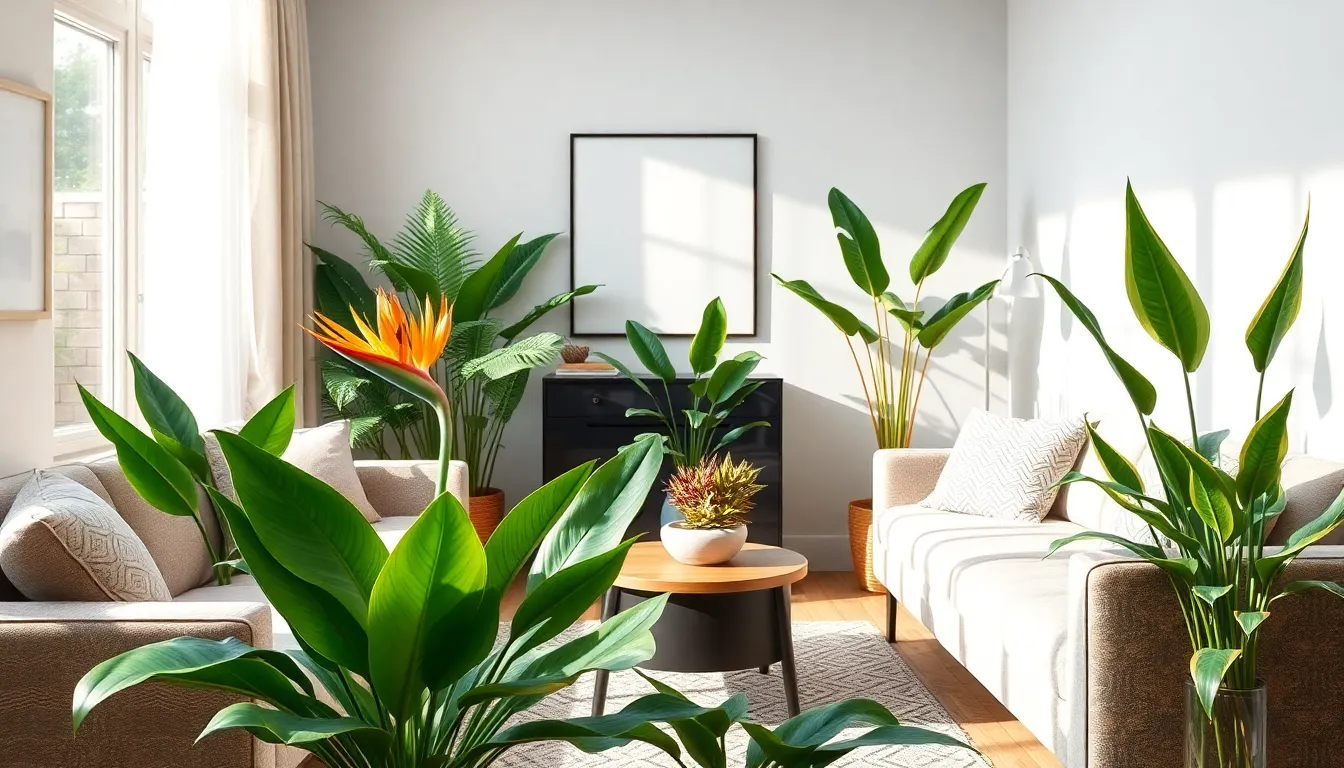
After determining the perfect size for your space, we need to focus on quality to ensure our faux plants deliver that authentic botanical appeal. Premium artificial plants designed by horticulturists and plant specialists capture the accurate texture, shape, and color that mirror real vegetation.
Look For Natural Color Variations And Textures
Quality faux plants feature subtle color gradations that replicate natural growth patterns rather than uniform coloring throughout. We recommend selecting plants with varying leaf shades, from deep emerald to lighter green tones, as these variations create the organic appearance found in living plants.
Textural elements make an enormous difference in realism. Plants with soft, velvety surfaces or glossy leaf finishes provide that tactile authenticity we’re seeking. Nearly Natural’s Real Touch collection exemplifies this attention to fine leaf details and natural patterns.
Combining different foliage types creates natural looking visual layers and depth in our arrangements. Consider mixing artificial bird of paradise with snake plants or pairing rubber leaf varieties with delicate succulents to achieve that curated yet organic aesthetic.
Choose Plants With Flexible Stems And Branches
Flexible stems and branches allow us to shape and position our artificial plants naturally, avoiding those telltale stiff postures that scream “fake plant.” This adaptability helps integrate the plant seamlessly into our living room setting while letting us adjust positioning near light sources for enhanced authenticity.
Bendable branches enable us to create realistic draping effects and natural curves that mimic how real plants grow and respond to their environment. We can manipulate these flexible elements to fill empty corners perfectly or create flowing arrangements that complement our furniture placement.
Invest In UV-Resistant Materials For Longevity
UV resistant materials maintain color vibrancy and structural integrity over time, especially when we place our faux plants near windows or in sunlit areas. This protection prevents the fading and brittleness that plague lower quality artificial plants.
These advanced materials ensure our investment stays vibrant and realistic without requiring replacement due to sun damage. We’ll maintain that fresh, botanical appearance year round while enjoying the benefits of natural light placement that enhances the overall realism of our artificial greenery.
Position Faux Plants In Natural Light Sources
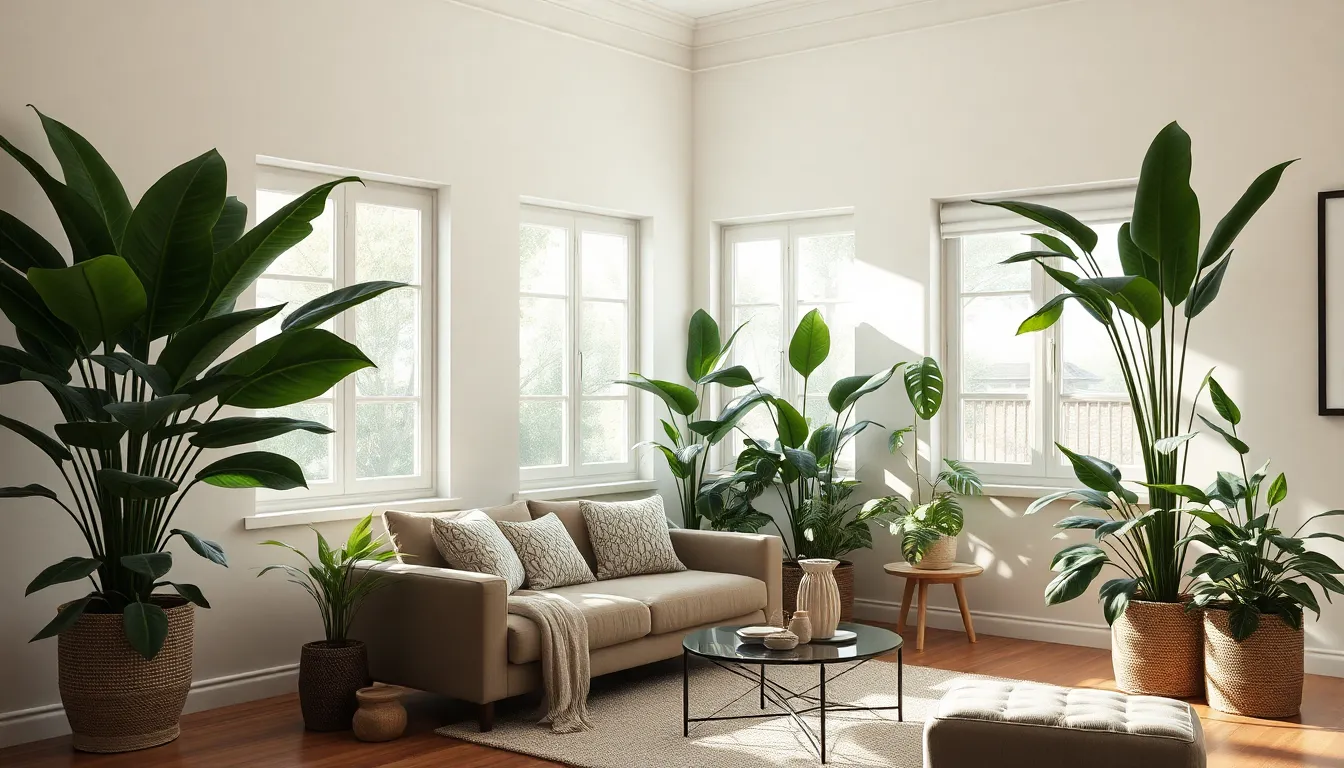
Now that we’ve selected the perfect size and quality faux plants for our living room, let’s explore strategic placement techniques that’ll make them look incredibly realistic. Strategic positioning near natural light sources creates the illusion that our artificial greenery is thriving just like real plants would.
Place Near Windows For Authentic Appearance
Windowsills and adjacent spaces provide the ideal foundation for our faux plant displays. We should arrange our artificial palms, succulents, and leafy varieties where genuine plants would naturally flourish – right beside those bright, sunny windows. This placement taps into our subconscious expectations since we’re accustomed to seeing living plants basking in natural light.
Positioning our faux greenery near windows leverages natural illumination to enhance visual credibility. The soft light filtering through glass highlights the textures and colors of our artificial foliage, making imperfections less noticeable while emphasizing realistic details. We’ll find that this strategic placement immediately elevates the authenticity of our living room’s botanical elements.
Use Corner Spaces To Create Depth
Large faux plants transform empty corners into ever-changing focal points that anchor our entire living space. We can position substantial floor plants like artificial fiddle leaf figs or tall palms in these often underutilized areas to add visual weight and dimension to our room’s layout.
Creating symmetrical arrangements works exceptionally well when we place two large plants on either side of major furniture pieces like our sofa or entertainment center. This balanced approach provides definition to our living room while establishing natural boundaries between different functional zones. Corner placement also prevents our artificial plants from interfering with foot traffic patterns.
Avoid Direct Sunlight To Prevent Fading
Direct sunlight poses the greatest threat to our faux plants’ longevity and vibrant appearance. We should position our artificial greenery in sheltered locations that receive ambient light rather than harsh, concentrated rays that can cause fading and deterioration of synthetic materials.
Bookshelves, side tables, and areas near but not directly in front of windows offer perfect compromise locations. These spots provide enough natural light to maintain realistic appearance while protecting our investment from UV damage. We’ll notice that our faux plants maintain their fresh, vibrant colors much longer when we’re mindful of sun exposure levels.
Mix Different Types Of Artificial Greenery
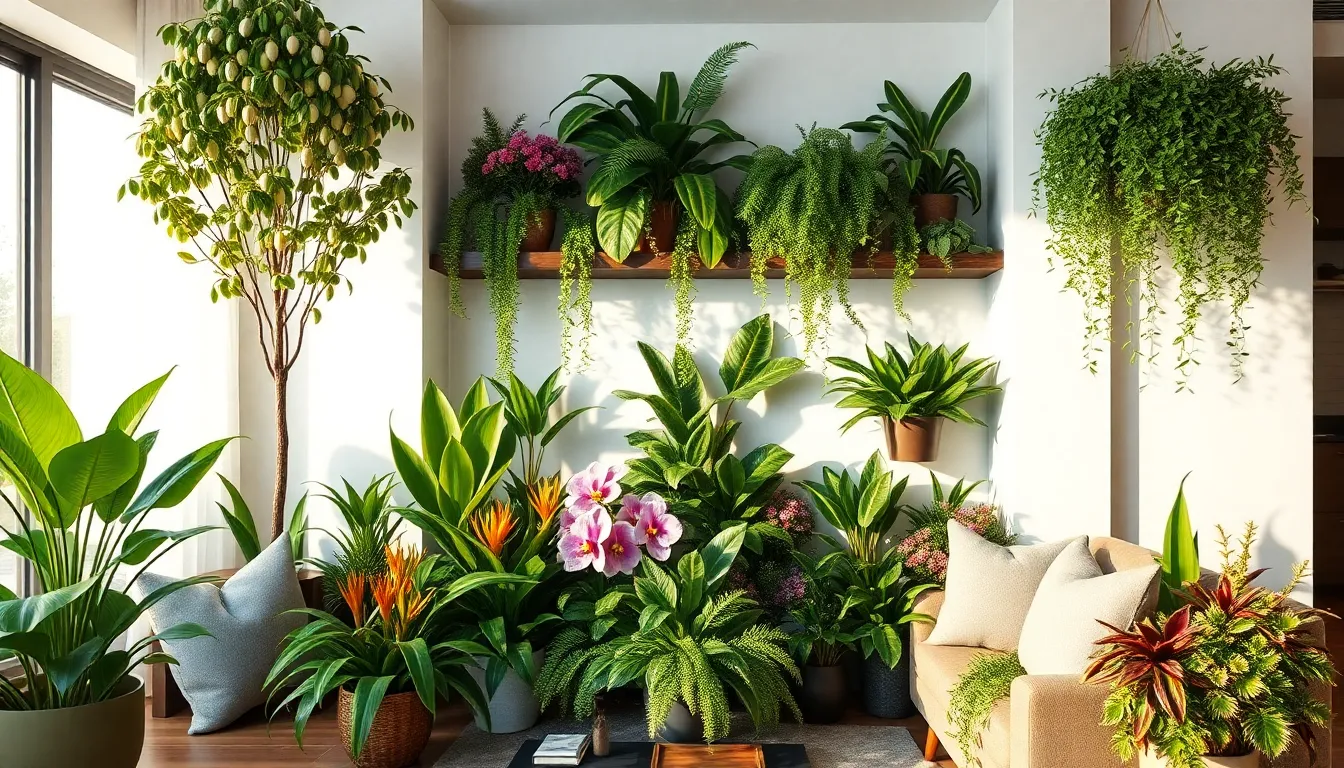
Creating visual interest in your living room starts with combining various types of artificial plants rather than relying on a single variety. We’ve found that pairing tall artificial trees like olive or bird of paradise with smaller leafy or flowering plants creates the most balanced and captivating arrangements.
Combine Leafy Plants With Flowering Varieties
Integrating faux plants that feature flowers alongside leafy greenery adds essential pops of color and contrast to your space. We recommend selecting flowering artificial plants such as orchids or colorful succulents to complement the green tones and diversify the visual texture throughout your room. Flowering varieties break up the monotony of all-green arrangements while introducing vibrant colors that can tie into your existing decor scheme. These blooming additions create focal points that draw the eye and add sophistication to your artificial plant collection.
Layer Different Textures And Shapes
Layering plants with different leaf shapes and textures transforms a flat arrangement into a dimensional display that mimics nature’s diversity. We suggest combining broad-leafed plants with fine foliage varieties and spiky succulents to add realistic depth to your living room setup. Choosing high-quality, realistic faux plants with true-to-life textures and natural color variations ensures your arrangement looks authentic rather than obviously artificial. Including decorative elements like faux moss or pebbles in your planters increases the authenticity of each display while adding another layer of textural interest.
Include Trailing Plants For Added Dimension
Adding trailing artificial plants that drape from shelves or hanging pots creates movement and fills vertical space throughout your living room. We position these cascading varieties strategically to break up rigid lines and add softness that encourages a lush, vibrant appearance. Hanging or trailing plants help draw the eye upward while creating natural-looking flow between different levels of your room. These draping elements work particularly well when paired with your floor plants and tabletop varieties to build comprehensive layers that enhance the overall aesthetic impact of your artificial greenery collection.
Use Stylish Planters To Enhance Your Decor
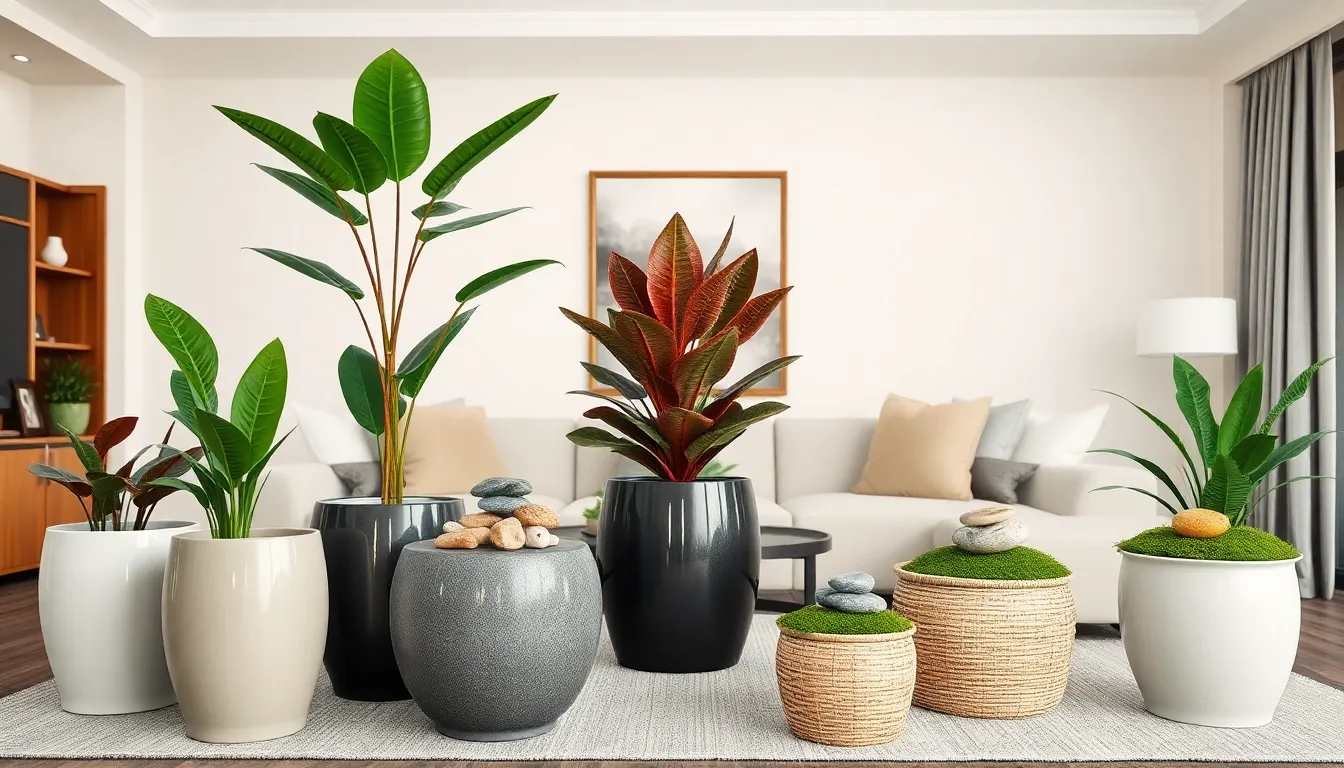
Choosing the right containers transforms ordinary faux plants into sophisticated design elements that complement your living room’s aesthetic. Beautiful planters create visual impact while ensuring your artificial greenery appears intentional rather than randomly placed.
Match Pot Materials To Your Interior Style
Materials play a crucial role in seamlessly integrating faux plants into your living room design. Modern minimalist spaces benefit from sleek ceramic or metal containers that echo clean lines and contemporary finishes. Rustic and bohemian interiors shine with woven baskets, terra cotta pots, or wooden planters that add warmth and texture.
Contemporary living rooms work beautifully with glossy ceramic planters in neutral tones or bold geometric shapes. Traditional spaces embrace classic materials like glazed pottery or brass containers that complement existing furniture finishes. Industrial style rooms pair perfectly with metal planters featuring matte black or weathered finishes that echo exposed beams or steel accents.
Consider Decorative Cachepots And Baskets
Cachepots provide an elegant solution for concealing basic plastic pots while adding visual interest to your faux plant arrangements. Decorative baskets soften the appearance of artificial foliage and introduce natural textures that enhance your living room’s warmth. Woven containers in seagrass, rattan, or jute create bohemian charm while offering easy seasonal swapping options.
Ceramic cachepots in coordinating colors allow you to change your plant display without purchasing new containers. Metallic finishes like copper or gold add luxury touches that elevate the perceived value of your faux greenery. Layering different sized cachepots creates depth and prevents arrangements from appearing flat or one dimensional.
Add Decorative Stones Or Moss For Realism
Decorative elements mask the artificial base of faux plants while creating convincing illusions of healthy root systems. Natural stones, river rocks, or decorative pebbles scattered across pot surfaces add authentic texture that draws the eye away from obviously fake soil. Spanish moss draped over container edges creates organic movement that mimics real plant growth patterns.
Colored glass stones introduce subtle sparkle that catches natural light and enhances the overall presentation. White decorative sand works particularly well with succulents and desert themed arrangements. Bark chips complement woodland style plants while adding earthy aromatics that further enhance the realistic experience.
Create Groupings For Maximum Visual Impact
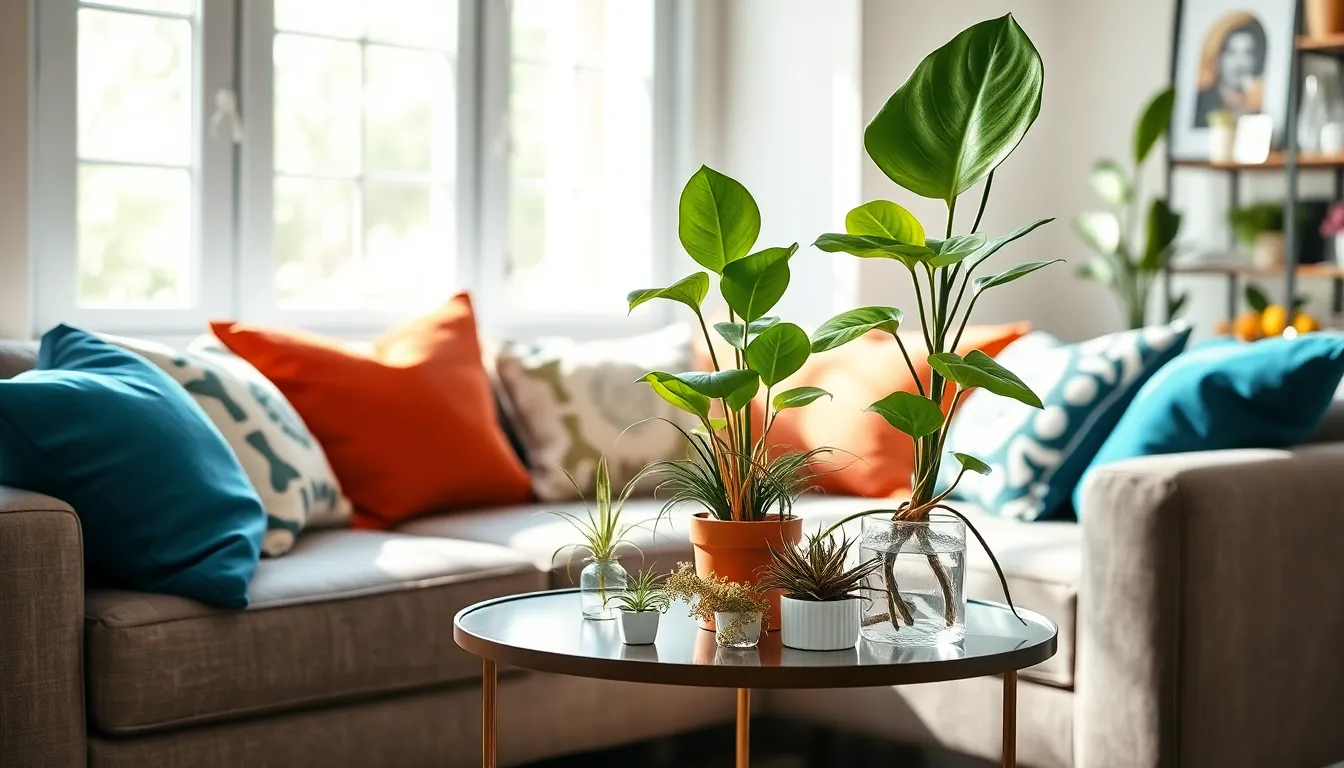
Grouping faux plants together creates far more dramatic visual appeal than scattering individual pieces throughout your living room. We’ve found that combining multiple artificial plants builds a cohesive natural atmosphere that draws attention and establishes focal points in your space.
Follow The Rule Of Odd Numbers
Odd numbered groupings consistently produce more visually appealing arrangements than even numbers. We recommend creating clusters of three or five faux plants to achieve that natural, asymmetrical quality that prevents your displays from looking overly staged. This design principle works because nature rarely creates perfectly symmetrical patterns, so groupings of three tall fiddle leaf figs or five mixed succulents will feel more organic and intentional in your living room.
Vary Heights Within Plant Arrangements
Height variation adds essential dimension and visual interest to your faux plant groupings. We suggest bending artificial stems or placing plants in containers of different heights to create natural, layered effects that mimic how real plants grow. Combining a tall snake plant with medium sized pothos and short air plants creates depth that catches the eye from multiple angles. Asymmetrical placement works better than uniform positioning because it reflects nature’s irregular growth patterns.
Leave Breathing Room Between Displays
Proper spacing prevents your faux plant arrangements from overwhelming the room or creating visual clutter. We recommend giving each grouping enough space to stand out individually while maintaining overall balance in your decor scheme. Consider scale and proportion when positioning your displays—large floor plants work perfectly in empty corners while smaller potted varieties enhance shelves and side tables without crowding the space.
Incorporate Faux Plants Into Existing Furniture
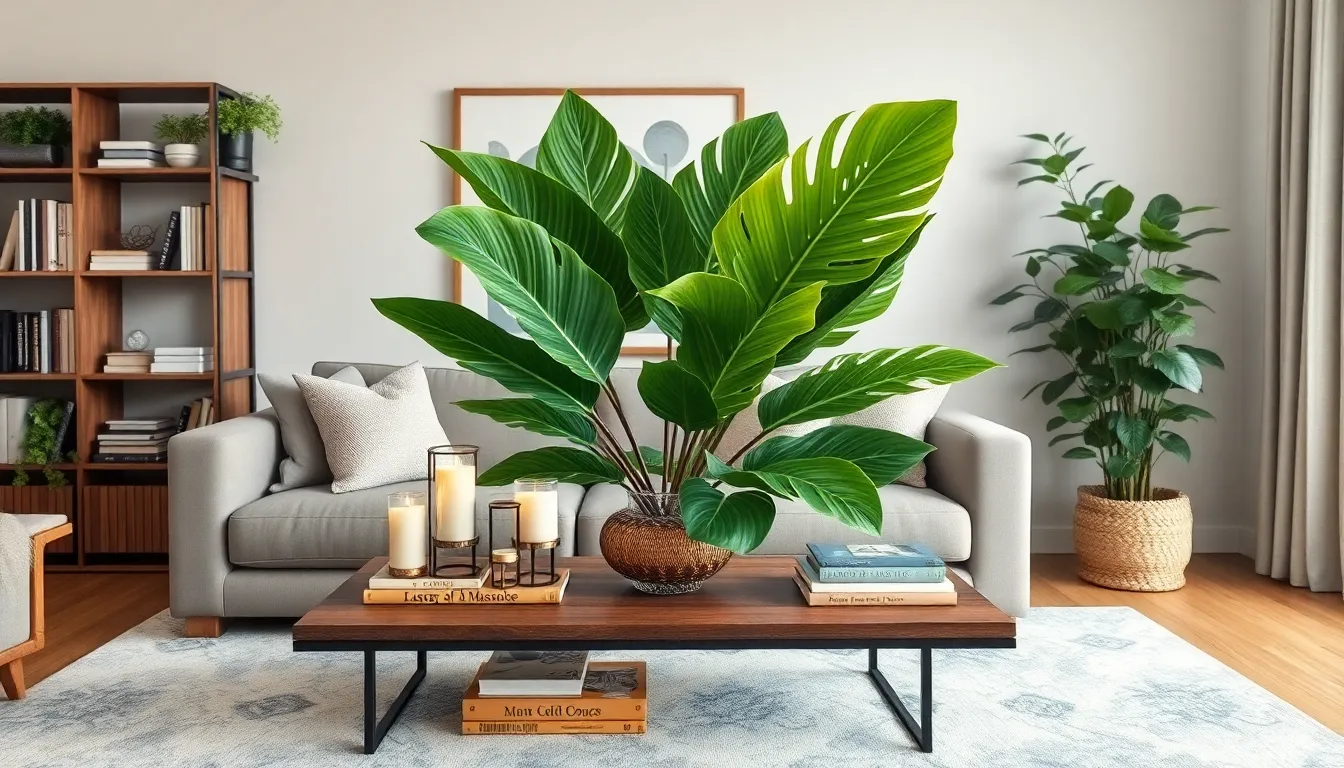
Building on our strategic placement approach, we’ll explore exact ways to integrate artificial greenery seamlessly with your current furniture pieces. This method maximizes the visual impact of faux plants while creating cohesive design elements throughout your living space.
Style Coffee Table Centerpieces
Coffee tables offer the perfect foundation for creating stunning faux plant displays that serve as conversation starters. We recommend arranging large tropical leaf stems in a decorative vase to brighten your coffee table while establishing a natural focal point. Grouping different textures and sizes together maintains visual interest without overwhelming the surrounding seating area.
Collections of artificial succulent varieties work exceptionally well when placed on stylish trays alongside decorative items like candles or coffee table books. These arrangements create layered displays that feel intentional and sophisticated. Varying the heights of your plant containers adds dimension to your centerpiece while ensuring the arrangement doesn’t obstruct conversation across the table.
Small topiaries in coordinating pots provide elegant symmetry when positioned at opposite ends of longer coffee tables. This approach creates balance while allowing space for functional items in the center of your surface.
Add Greenery To Bookshelves And Mantels
Bookshelves and mantels present excellent opportunities to incorporate faux plants that fill empty spaces while adding organic elements to your displays. Faux pothos and ferns rank among the most popular choices for these locations due to their realistic appearance and adaptability to various décor styles.
Strategically placing small to medium sized artificial plants helps break up rows of books and decorative objects, creating breathing room between collections. We suggest positioning plants at different shelf levels to establish visual rhythm throughout your bookcase arrangement. This technique prevents your shelves from appearing cluttered while adding natural color variation.
Mantels benefit from asymmetrical groupings that balance other decorative elements like picture frames or candlesticks. Trailing varieties work particularly well when positioned at mantel edges, where their cascading foliage softens hard architectural lines. Coordinating your plant containers with existing mantel accessories creates a cohesive look that feels intentionally curated.
Use Floor Plants To Fill Empty Corners
Empty corners represent untapped potential for transforming your living room’s atmosphere with strategically placed floor plants. Artificial large leafy plants such as palms or fiddle leaf figs excel at filling these underutilized spaces while adding both height and textural softness to your room’s overall composition.
Attractive planters or woven baskets enhance the realistic appearance of your faux floor plants while complementing your existing furniture finishes. Adding decorative filler like artificial moss inside containers creates a finished look that conceals any visible artificial bases. This attention to detail significantly improves the overall authenticity of your plant displays.
Floor positioned faux plants bring warmth and natural texture to living rooms without requiring watering schedules or exact lighting conditions. We recommend selecting plants that match your room’s scale, choosing substantial varieties for spacious areas and more modest options for cozy corners. Positioning these plants near natural light sources further enhances their realistic appearance while creating the illusion of thriving greenery.
Maintain Your Artificial Plants For Long-Lasting Beauty
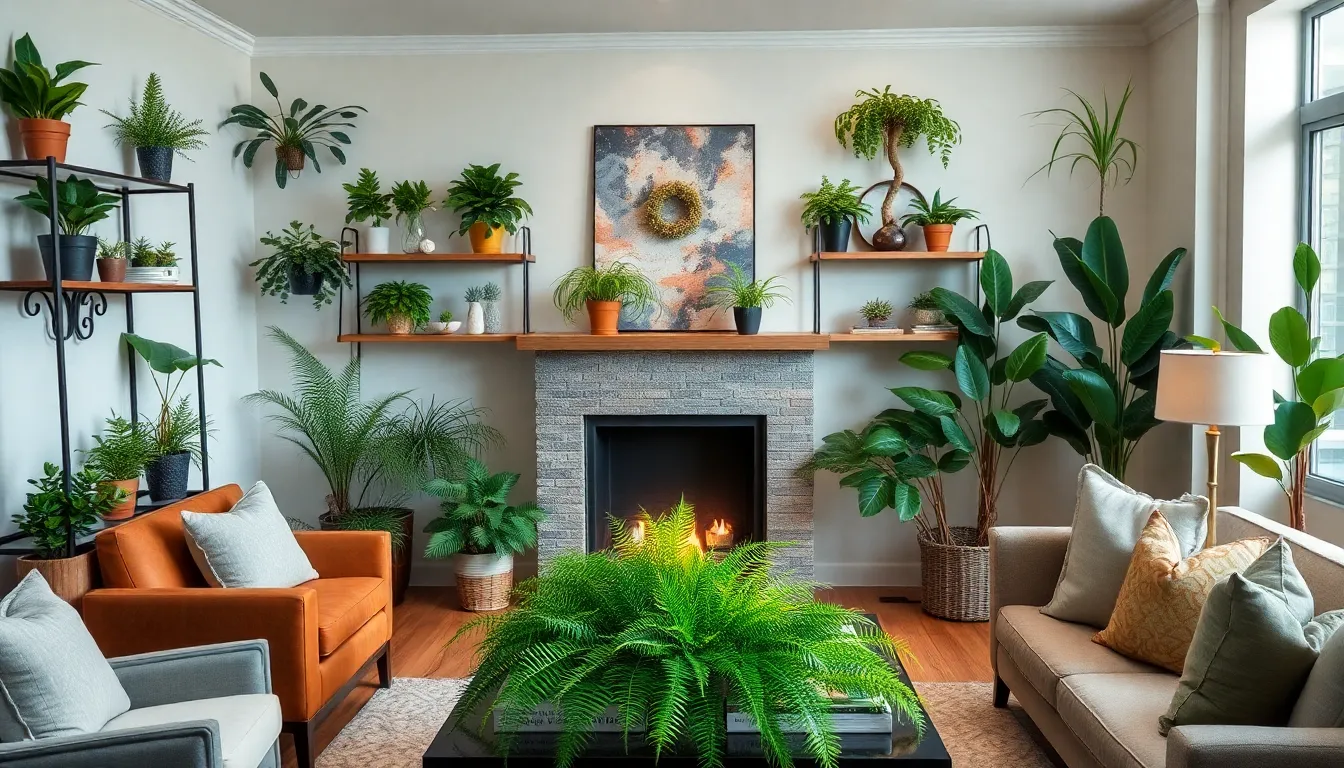
While faux plants don’t require watering or pruning, they do need proper care to preserve their realistic appearance and vibrant colors. Regular maintenance ensures your artificial greenery continues to enhance your living room decor for years to come.
Dust Regularly With Soft Cloths Or Brushes
Dust accumulation is the biggest enemy of artificial plants, causing leaves to appear dull and lifeless over time. We recommend using a soft microfiber cloth, feather duster, or gentle brush to remove dust from all plant surfaces at least once a week. This simple routine maintains the vibrant appearance of your faux foliage and prevents buildup that can make plants look obviously artificial.
Start from the top of each plant and work your way down, paying special attention to intricate leaves and textured surfaces where dust tends to collect. For plants with delicate or small leaves like artificial ferns or eucalyptus, a soft paintbrush works exceptionally well to reach tight spaces without damaging the materials.
Clean With Gentle Soap Answers When Needed
Stubborn grime and sticky residue require more thorough cleaning than regular dusting can provide. Mix a few drops of mild dish soap with warm water to create a gentle cleaning solution that won’t damage your artificial plants. Apply the solution using a soft cloth or washcloth for spot cleaning problem areas.
Plastic varieties can tolerate slightly more vigorous cleaning than silk or fabric plants, but always test the solution on a hidden area first. Rinse thoroughly with clean water and allow plants to air dry completely before returning them to their display positions to prevent water spots or damage.
Rotate Plants To Prevent Uneven Wear
Environmental factors like sunlight and room lighting can cause uneven fading or discoloration if plants remain in the same position for extended periods. We suggest rotating your faux plants every few weeks to ensure even exposure and prevent concentrated wear on one side. This practice helps maintain consistent coloring across all plant surfaces.
Moving plants around your living room also gives you opportunities to refresh your decor arrangement and discover new positioning options that might work better with your furniture layout. Strategic rotation prevents the telltale signs of artificial plants while extending their lifespan significantly.
Conclusion
We’ve explored how faux plants can transform your living room into a green sanctuary without the commitment of caring for real plants. From selecting the right sizes and quality materials to mastering placement techniques and creating stunning arrangements these artificial beauties offer endless possibilities for improving your space.
The key to success lies in treating your faux plants as seriously as you would real ones. Choose high-quality pieces invest in stylish planters and don’t forget those simple maintenance tasks that keep them looking fresh. With proper selection and thoughtful placement you’ll create a living room that feels naturally vibrant year-round.
Your perfect low-maintenance oasis awaits – it’s time to bring those green dreams to life with confidence and style.
Frequently Asked Questions
What are the main benefits of using faux plants in home decor?
Faux plants offer low-maintenance beauty for busy lifestyles or those without gardening skills. Modern artificial plants look incredibly realistic while providing consistent greenery without watering, pruning, or worrying about plant health. They’re perfect for creating a beautiful living space without the commitment of caring for real plants.
How do I choose the right size faux plants for my living room?
Select plant sizes based on your room’s proportions and ceiling height. Use larger floor plants in spacious areas and smaller tabletop varieties in compact spaces. Match plant scale to furniture size – pair oversized sofas with substantial floor plants, while smaller furniture works better with compact arrangements.
What should I look for when buying high-quality artificial plants?
Focus on realistic textures, natural color variations, and flexible stems for authentic appearance. Choose plants with bendable branches and UV-resistant materials to ensure longevity. Look for artificial plants that closely mimic real foliage with varied leaf shapes and natural imperfections for maximum realism.
Where should I place faux plants for the most realistic look?
Position faux plants near natural light sources like windows to highlight their textures and colors. Use corner spaces for large plants to add depth, and create symmetrical arrangements for balance. Avoid direct sunlight which can cause fading – choose sheltered locations with ambient light instead.
How can I create visual interest with artificial plant arrangements?
Mix different types of greenery by pairing tall trees with smaller plants. Combine leafy varieties with flowering plants like orchids for color contrast. Layer different textures and shapes, and include trailing plants to add movement and fill vertical space for dynamic displays.
What type of planters work best with faux plants?
Match pot materials to your interior style – use sleek ceramics for modern spaces and rustic baskets for bohemian aesthetics. Utilize decorative cachepots to conceal basic plastic pots. Add decorative stones or moss to mask artificial bases and create a more realistic, sophisticated appearance.
How should I group faux plants for maximum impact?
Create clusters using odd numbers of plants for an organic look. Vary heights within arrangements to add dimension and visual interest. Leave breathing room between displays to prevent clutter. Group plants together to create a cohesive natural atmosphere that enhances your room’s overall design.
How do I maintain my faux plants to keep them looking fresh?
Dust regularly with soft cloths or brushes to prevent dullness. For stubborn grime, use a gentle soap solution for spot cleaning. Rotate plants every few weeks to prevent uneven wear and fading. This simple maintenance routine will keep your artificial plants looking vibrant for years.

